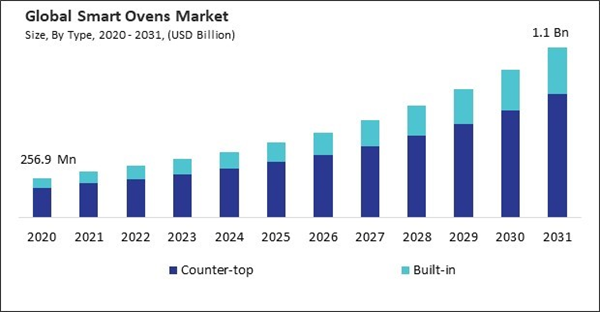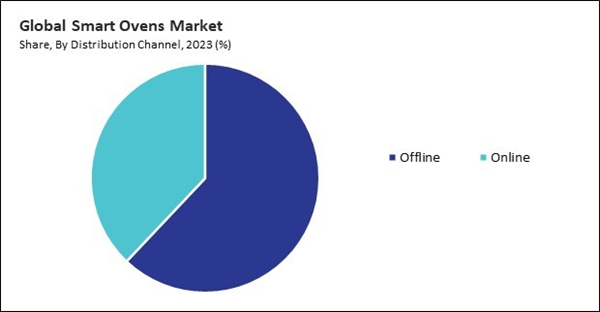The Global Smart Ovens Market size is expected to reach $1.1 billion by 2031, rising at a market growth of 14.5% CAGR during the forecast period. In the year 2023, the market attained a volume of 5,116.2 hundred Units, experiencing a growth of 15.2% (2020-2023).
Online shopping offers consumers the convenience of browsing and purchasing smart ovens from the comfort of their homes without needing to visit physical stores. Consumers can choose the delivery option that best suits their needs, ensuring a seamless shopping experience. Hence, the Online segment captured $143.7 million revenue in the market in the year 2023. In terms of volume, there were 1,857.3 hundred units of Smart Ovens were sold Online, globally. Online retail platforms use algorithms to provide personalized product recommendations based on consumer browsing and purchasing history. This helps consumers discover new smart oven options that align with their preferences and needs, increasing the likelihood of a purchase.
Smart ovens provide nutritional information and calorie tracking for recipes, allowing users to make informed meal decisions. This feature helps consumers track their calorie intake and make healthier food choices, contributing to their overall health and well-being. Smart ovens offer diet-specific recipe suggestions, including vegetarian, vegan, and gluten-free options and other dietary restrictions. This allows consumers to find recipes that align with their dietary preferences and restrictions, making it easier to maintain a healthy diet.
Additionally, Higher-income consumers are often early adopters of smart home technology. As the trend towards smart homes grows, smart ovens are becoming essential to modern kitchen design, appealing to consumers who value convenience, efficiency, and connectivity. Consumers with higher disposable income often prefer to invest in high-quality, premium home appliances. Therefore, due to above mentioned factors, the market is growing.
However, the high initial cost of smart ovens can be prohibitive for many consumers, particularly those on a tight budget. Affordability is a significant factor influencing purchasing decisions, and the high cost of smart ovens may deter potential buyers. Price-sensitive consumers may opt for traditional ovens over smart ovens due to their lower cost. Smart oven manufacturers may face a competitive disadvantage if their products are significantly more expensive than traditional ovens. Consumers may choose lower-cost alternatives, reducing market growth for smart oven manufacturers. Thus, high initial cost can slow down the growth of the market.
Online shopping offers consumers the convenience of browsing and purchasing smart ovens from the comfort of their homes without needing to visit physical stores. Consumers can choose the delivery option that best suits their needs, ensuring a seamless shopping experience. Hence, the Online segment captured $143.7 million revenue in the market in the year 2023. In terms of volume, there were 1,857.3 hundred units of Smart Ovens were sold Online, globally. Online retail platforms use algorithms to provide personalized product recommendations based on consumer browsing and purchasing history. This helps consumers discover new smart oven options that align with their preferences and needs, increasing the likelihood of a purchase.
Smart ovens provide nutritional information and calorie tracking for recipes, allowing users to make informed meal decisions. This feature helps consumers track their calorie intake and make healthier food choices, contributing to their overall health and well-being. Smart ovens offer diet-specific recipe suggestions, including vegetarian, vegan, and gluten-free options and other dietary restrictions. This allows consumers to find recipes that align with their dietary preferences and restrictions, making it easier to maintain a healthy diet.
Additionally, Higher-income consumers are often early adopters of smart home technology. As the trend towards smart homes grows, smart ovens are becoming essential to modern kitchen design, appealing to consumers who value convenience, efficiency, and connectivity. Consumers with higher disposable income often prefer to invest in high-quality, premium home appliances. Therefore, due to above mentioned factors, the market is growing.
However, the high initial cost of smart ovens can be prohibitive for many consumers, particularly those on a tight budget. Affordability is a significant factor influencing purchasing decisions, and the high cost of smart ovens may deter potential buyers. Price-sensitive consumers may opt for traditional ovens over smart ovens due to their lower cost. Smart oven manufacturers may face a competitive disadvantage if their products are significantly more expensive than traditional ovens. Consumers may choose lower-cost alternatives, reducing market growth for smart oven manufacturers. Thus, high initial cost can slow down the growth of the market.
Driving and Restraining Factors
Drivers- Growing Trend Towards Online Shopping
- Increasing Interest in Healthy Eating
- Higher Level of Disposable Income
- High Initial Cost of Smart Ovens
- Reliability And Durability Concerns
- Expansion Of IoT and Connectivity Features
- Rising Awareness of Education and Campaigns
- Adverse Impact of Complex Installation Process
- Lack Of Standardization in Smart Ovens
Type Outlook
By type, the market is bifurcated into counter-top and built-in. In 2023, the counter-top segment held 75% revenue share in the market. In terms of volume, 15,514.0 hundred units of Counter-top smart ovens are expected to be sold utilized by the year 2031. Counter-top smart ovens are easy to install and do not require any modifications to existing kitchen setups. Users can place them on their kitchen countertops and plug them into a power outlet, eliminating the need for professional installation.Distribution Channel Outlook
On the basis of distribution channel, the market is divided into offline and online. The online segment garnered 38% revenue share in the market in 2023. In terms of volume, 6,599.5 hundred units of Smart Ovens are expected to be sold online by the year 2031. Online retail channels offer consumers the convenience of shopping for smart ovens anytime, day or night. With 24/7 availability, consumers can browse products, compare prices, and make purchases conveniently without being limited by store hours. Online retail platforms provide access to product reviews and ratings from other consumers, helping potential buyers make informed purchasing decisions.End User Outlook
Based on end user, the market is classified into residential and commercial. The commercial segment acquired 32% revenue share in the smart ovens market in 2023. Also, 3,204.8 hundred units of Smart ovens are expected to be utilized for commercial use. Smart ovens save time and labor in commercial kitchens by automating various cooking tasks. Features such as pre-programmed cooking modes, recipe libraries, and remote monitoring allow chefs to prepare meals more quickly and efficiently, reducing the need for manual supervision.Regional Outlook
Region-wise, the market is analyzed across North America, Europe, Asia Pacific, and LAMEA. In 2023, the North America region led the market by generating 37% revenue share. In terms of volume, 1,923.6 hundred units of smart Ovens were utilized in the year 2023. North America has witnessed a surge in demand for smart home appliances, including smart ovens. There is a growing trend towards healthy eating in North America, with consumers increasingly concerned about their diet and nutrition. Rising disposable income among consumers in North America has contributed to the growing demand for smart ovens.Recent Strategies Deployed in the Market
- Apr-2024: LG Electronics revealed its brand-new Signature Kitchen Suite built-in oven, free zone induction hob, and downdraft hood. Featuring Advanced AI Technologies and Sleek Design, the company's expanded lineup of built-in appliances brings outstanding convenience and style to the kitchen.
- Aug-2023: LG Electronics partnered with ITC Foods, a diversified conglomerate, to provide customers a more convenient, healthier, and more versatile cooking experience. The LG Charcoal Healthy Ovens feature Wi-Fi connectivity and can be conveniently controlled through the LG ThinQ app. This functionality enables users to scan the barcode on an ITC Master Chef frozen food packet and effortlessly send the cooking instructions directly to the oven with just a touch of a button.
- Feb-2023: Samsung Electronics launched Series 7 Bespoke AI Oven. This cutting-edge appliance incorporates powerful and intelligent AI Pro Cooking technology, enabling it to create delicious meals tailored to users’ specific dietary requirements. The Bespoke AI Oven features a sleek and minimalist design, complemented by a convenient auto-open door, enhancing both functionality and aesthetic appeal. The launch of the Series 7 Bespoke AI Oven reflects Samsung's commitment to delivering innovative solutions that elevate the cooking process while meeting the diverse needs of consumers.
- Feb-2023: Tovala introduced its Smart Oven Air Fryer, available in a sleek stone-gray finish. With the introduction of the Tovala Smart Oven Air Fryer, achieving crispier, best-in-class air frying results has never been easier - simply scan a QR code, and exceptional air frying is at your fingertips.
- Aug-2022: Panasonic launched wide range of products 4K and Smart TV portfolios, alongside a Smart line-up of Washing Machines powered by Miraie - an IoT enabled platform by Panasonic. Additionally, we offer a 30 Litre Microwave Oven featuring zero oil recipes and Monster Super Mixer Grinders equipped with Double Safety Lock for enhanced safety. Through these launches, the company focuses on achieving double-digit growth, bolstered by our comprehensive range of home appliances.
List of Key Companies Profiled
- LG Electronics, Inc. (LG Corporation)
- Whirlpool Corporation
- Sharp Corporation
- Hitachi, Ltd.
- Robert Bosch GmbH
- Panasonic Corporation
- Samsung Electronics Co., Ltd.
- Techtronic Industries Co., Ltd.
- Tovala
- June Life, Inc.
Market Report Segmentation
By Type (Volume, Hundred Units, USD Billion, 2020-2031)- Counter-top
- Built-in
- Offline
- Online
- Residential
- Commercial
- North America
- US
- Canada
- Mexico
- Rest of North America
- Europe
- Germany
- UK
- France
- Russia
- Spain
- Italy
- Rest of Europe
- Asia Pacific
- China
- Japan
- India
- South Korea
- Australia
- Malaysia
- Rest of Asia Pacific
- LAMEA
- Brazil
- Argentina
- UAE
- Saudi Arabia
- South Africa
- Nigeria
- Rest of LAMEA
Table of Contents
Chapter 1. Market Scope & Methodology
Chapter 2. Market at a Glance
Chapter 3. Market Overview
Chapter 5. Global Smart Ovens Market by Type
Chapter 6. Global Smart Ovens Market by Distribution Channel
Chapter 7. Global Smart Ovens Market by End User
Chapter 8. Global Smart Ovens Market by Region
Chapter 9. Company Profiles
Companies Mentioned
- LG Electronics, Inc. (LG Corporation)
- Whirlpool Corporation
- Sharp Corporation
- Hitachi, Ltd.
- Robert Bosch GmbH
- Panasonic Corporation
- Samsung Electronics Co., Ltd.
- Techtronic Industries Co., Ltd.
- Tovala
- June Life, Inc.
Methodology

LOADING...










